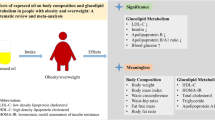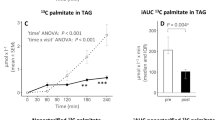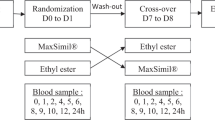Abstract
Objective:
To study whether olive oil and rapeseed oil have different effects on cholesterol metabolism.
Design:
Short-term experimental study, with controlled diets.
Setting:
Outpatients at a metabolic-ward kitchen.
Subjects:
A total of nine volunteers with conventional ileostomies.
Interventions:
Two 3-day diet periods; controlled diet including 75 g of rapeseed oil or olive oil.
Main outcome measures:
Cholesterol absorption, ileal excretion of cholesterol, and bile acids. Serum levels of cholesterol and bile acid metabolites. Differences between diets evaluated with Wilcoxon's signed rank sum test.
Results:
Rapeseed oil diet contained 326 mg more plant sterols than the olive oil diet. Rapeseed oil tended to decrease cholesterol absorption by 11% (P=0.050), and increased excretion of cholesterol, bile acids, and their sum as sterols by 9% (P=0.021), 32% (P=0.038), and 51% (P=0.011) compared to olive oil. A serum marker for bile acid synthesis (7α-hydroxy-4-cholesten-3-one) increased by 28% (P=0.038) within 10 h of consumption, and serum cholesterol levels decreased by 7% (P=0.024), whereas a serum marker for cholesterol synthesis (lathosterol) as well as serum levels of plant sterols remained unchanged.
Conclusions:
Rapeseed oil and olive oil have different effects on cholesterol metabolism. Rapeseed oil, tends to decrease cholesterol absorption, increases excretion of cholesterol and bile acids, increases serum marker of bile acid synthesis, and decreases serum levels of cholesterol compared to olive oil. This could in part be explained by different concentrations of natural plant sterols.
Sponsorship:
Supported by the Göteborg Medical Society, the Swedish Medical Society, the Swedish Board for Agricultural Research (SJFR) grant 50.0444/98 and by University of Göteborg.
This is a preview of subscription content, access via your institution
Access options
Subscribe to this journal
Receive 12 print issues and online access
$259.00 per year
only $21.58 per issue
Buy this article
- Purchase on Springer Link
- Instant access to full article PDF
Prices may be subject to local taxes which are calculated during checkout
Similar content being viewed by others
References
Andersson H & Bosaeus I (1993): Sterol balance studies in man. A critical review. Eur. J. Clin. Nutr. 47, 153–159.
Andersson M, Ellegård L & Andersson H (2002): Oat bran stimulates bile acid synthesis in 8 h as measured by 7a-hydroxy-4-cholestene-3-one. Am. J. Clin. Nutr. 76, 1111–1116.
Andersson S, Skinner J, Ellegård L, Welch A, Bingham S, Mulligan A, Andersson H & Khaw K (2004): Intake of plant sterols is inversely related to serum cholesterol concentration in men and women in the EPIC Norfolk population: a cross sectional study. Eur. J. Clin. Nutr. 58, 1378–1385.
Axelson M, Aly A & Sjövall J (1988): Levels of 7alfa-hydroxy-4-cholesten-3-one in plasma reflect rates of bile acid synthesis in man. FEBS Lett. 239, 324–328.
Bosaeus I, Belfrage L, Lindgren C & Andersson H (1992): Olive oil instead of butter increases net cholesterol excretion from the small bowel. Eur. J. Clin. Nutr. 46, 111–115.
Bosaeus IG & Andersson HBO (1987): Short-term effect of two cholesterol-lowering diets on sterol excretion in ileostomy patients. Am. J. Clin. Nutr. 45, 54–59.
Bosaeus IG, Carlsson NG, Sandberg AS & Andersson H (1986): Effect of wheat bran and pectin on bile acid and cholesterol excretion in ileostomy patients. Hum. Nutr. Clin. Nutr. 40C, 429–440.
Connor WE, Witiak DT, Stone DB & Armstrong ML (1969): Cholesterol balance and fecal neutral steroid and bile acid excretion in normal men fed dietary fats of different fatty acid composition. J. Clin. Invest. 48, 1363–1375.
Ellegård L, Andersson H, Bosaeus I, Langkilde A-M & Lia Å (2000a): Bioactive micronutrients in mediterranean diet and health. In COST 916 Action: Bioactive Plant Cell Wall Components in Nutrition and Health eds Amado R, Lairon D, Gerber M, Maiani G & Abt B, p 35, Luxembourg: Office for the official publications of the European communities.
Ellegård L & Bosaeus I (1991): Sterol and nutrient excretion in ileostomists on prudent diets. Eur. J. Clin. Nutr. 45, 451–457.
Ellegård L & Bosaeus I (1994): Cholesterol absorption and excretion in ileostomy subjects on high- and low-dietary cholesterol intakes. Am. J. Clin. Nutr. 59, 48–52.
Ellegard L, Bosaeus I & Andersson H (2000b): Will recommended changes in fat and fibre intake affect cholesterol absorption and sterol excretion? An ileostomy study. Eur. J. Clin. Nutr. 54, 306–313.
Grundy SM & Ahrens EH (1969): Measurements of cholesterol turnover, synthesis and absorption in man, carried out by isotope kinetic and balance methods. J. Lipid Res. 10, 91–107.
Katan MB, Grundy SM, Jones P, Law M, Miettinen T & Paoletti R (2003): Efficacy and safety of plant stanols and sterols in the management of blood cholesterol levels. Mayo. Clin. Proc. 78, 965–978.
Lia A, Hallmans G, Sandberg A, Sundberg B & Andersson H (1995): Oat beta-glucan increases bile acid excretion and a fiber-rich barley fraction increases cholesterol excretion in ileostomy subjects. Am. J. Clin. Nutr. 62, 1245–1251.
Miettinen TA (1982): Gas liquid chromatographic determination of fecal neutral sterols using a capillary column. Clin. Chim. Acta 124, 245–248.
Miettinen TA, Vuoristo M, Nissinen M, Järvinen HJ & Gylling H (2000): Serum, biliary, and fecal cholesterol and plant sterols in colectomized patients before and during consumption of stanol ester margarine. Am. J. Clin. Nutr. 71, 1095–1102.
Nestel PJ, Havenstein N, Homma Y, Scott TW & Cook LJ (1975): Increased sterol excretion with polyunsaturated-fat high-cholesterol diets. Metabolism 24, 189–198.
Normén L, Dutta P, Lia Å & Andersson H (2000): Soy sterol esters and beta-sitostanol ester as inhibitors of cholesterol absorption in human small bowel. Am. J. Clin. Nutr. 71, 908–913.
Ostlund RE, Racette SB, Okeke A & Stenson WF (2002): Phytosterols that are naturally present in commercial corn oil significantly reduce cholesterol absorption in humans. Am. J. Clin. Nutr. 75, 1000–1004.
Ostlund RE, Racette SB & Stenson WF (2003): Inhibition of cholesterol absorption by phytosterol-replete wheat germ compared with phytosterol-depleted wheat germ. Am. J. Clin. Nutr. 77, 1385–1389.
Pedersen A, Baumstark MW, Marckman P, Gylling H & Sandström B-M (2000): An olive oil-rich diet results in higher concentrations of LDL cholesterol and a higher number of LDL subfraction particles than rapeseed oil and sunflower oil diets. J. Lipid Res. 41, 1901–1911.
Sandberg AS, Andersson H, Hallgren B, Hasselblad K & Isaksson B (1981): Experimental model for in vivo determination of dietary fibre and its effects on the absorption of nutrients in the small intestine. Br. J. Nutr. 45, 283–294.
Swedish National Food Administration (1996): Food Composition Table—Energy and Nutrients. Uppsala, Sweden: Livsmedelsverket.
Truswell AS & Choudhury N (1998): Monounsaturated oils do not all have the same effect on plasma cholesterol. Eur. J. Clin. Nutr. 52, 312–315.
Wood D, De Backer G, Fargeman O, Graham I, Mancia G & Pyörälä K (1998): Prevention of coronary heart disease in clinical practice. Summary of recommendations of the second joint task force of European and other societies on coronary prevention. J. Hypertens. 10, 1407–1414.
Acknowledgements
The expertise and technical assistance provided by Vibeke Malmros is greatly appreciated. Supported by the Gothenburg Medical Society, Grant number: 91/00, the Swedish Board for Agricultural Research (SJFR) Grant 50.0444/98, the Swedish Medical Society, Grant number 2002-405 and from the Sahlgrenska University Hospital under the LUA-agreement.
Author information
Authors and Affiliations
Corresponding author
Additional information
Guarantor: L Ellegård.
Contributors: LE was the principal investigator, IB and HA contributed to the study design, and all contributed to writing this paper.
Rights and permissions
About this article
Cite this article
Ellegård, L., Andersson, H. & Bosaeus, I. Rapeseed oil, olive oil, plant sterols, and cholesterol metabolism: an ileostomy study. Eur J Clin Nutr 59, 1374–1378 (2005). https://doi.org/10.1038/sj.ejcn.1602249
Received:
Revised:
Accepted:
Published:
Issue Date:
DOI: https://doi.org/10.1038/sj.ejcn.1602249
Keywords
This article is cited by
-
Effects of camelina oil supplementation on lipid profile and glycemic control: a systematic review and dose‒response meta-analysis of randomized clinical trials
Lipids in Health and Disease (2022)
-
Exogenous Zinc Forms Counteract NaCl-Induced Damage by Regulating the Antioxidant System, Osmotic Adjustment Substances, and Ions in Canola (Brassica napus L. cv. Pactol) Plants
Journal of Soil Science and Plant Nutrition (2019)



